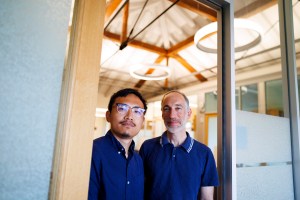When light speed is too slow
Alex Wissner-Gross says the future isn’t coming fast enough.
Consider the predictions of the 1950s, he says. Here we are, 10 years past the millennium, and what do we have to show for ourselves?
“We’re supposed to have ubiquitous space travel and exploration. We’re supposed to have flying cars. We’re supposed to have ocean cities, atomic vacuum cleaners… These technologies never panned out.”
The limiting factor, he says, is energy—energy generation and energy storage. We can build tiny robots with sophisticated AI, but when we demonstrate them in the lab, like us, they’re still tethered to the wall by a power cord.
Wissner-Gross (A.M., Ph.D. ’07) has two great passions. The first is this conviction that inefficiencies in infrastructure shouldn’t prevent innovation. The second is the concept of programmable matter, where the physical world of heat, chemistry, and magnetism, for example, intersect with computation.
While preparing to write his doctoral thesis on programmable surfaces four years ago, he drew up a matrix of every possible way of converting one type of physical signal—e.g. a fluid flow, an electrical signal, or a thermal signal—into every other type. The chart brought together aspects of many seemingly disparate fields, providing not just a unifying perspective, but also a useful tool.
“It turns out that a lot of the entries in that matrix have been filled by very high-impact research in the past,” says Wissner-Gross. As part of his thesis, he used gaps in the matrix to identify areas of potential new research, several of which he has explored as a postdoctoral fellow at Harvard’s School of Engineering and Applied Sciences (SEAS) and now as a research affiliate in the MIT Media Laboratory.
His recent research has run the gamut from physics, his native subject, through Earth science, computer science, and mathematics, ending up—of all places—in finance.
Then, as the path of his research veered towards finance, he wondered, “What happens when we put so much programmable hardware all over the Earth that it actually affects the way information propagates and the way finance is done?”
In a paper published Nov. 1 in the journal Physical Review E, he offers responses to these questions. The idea behind “Relativistic Statistical Arbitrage,” which he co-wrote with Cameron Freer (Ph.D. ’08), an instructor in pure mathematics at MIT, is that high-frequency financial trading now happens so quickly that the data network it relies on is holding it back.





